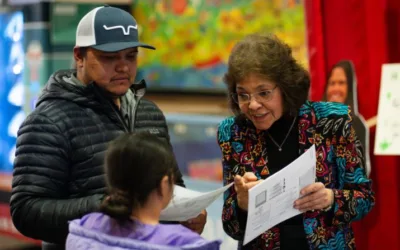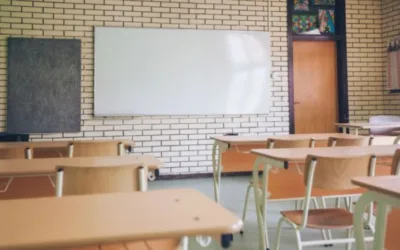Whatever form school takes in the fall—virtual, in-person, or a hybrid of the two—the school district has a plan for it. The problem is, will such plans keep everyone safe and ensure a quality education?
A new “Smart Start” plan approved by Teton County School District’s board of trustees Wednesday is based on guidelines from the state, as well as local and national public health departments. It offers different school scenarios depending on the COVID threat in the community or in the schools. The plan, required by the Wyoming Department of Education, attempts to wrangle some kind of order out of the chaos COVID has created. But it has holes, leaving parents and teachers in limbo.
The plan has three tiers for three scenarios—in-person classes, virtual classes, and a hybrid option. The tiers are designed to allow schools to quickly respond to changing COVID-related issues while providing some modicum of seamless education.
Teton County School District superintendent Dr. Gillian Chapman acknowledged the plan is not perfect. And it may need to morph many more times before classes are slated to begin on September 1.
“We know people want answers and they want to be able to make plans,” she said at the school board meeting. “If there is one thing we learned from the pandemic, it is that we can plan and plan, but really we can’t. So, we have plans in place, but we also realize they may change.”
Education vs. The Economy
At issue is the evolving landscape of the novel coronavirus and its spread. Communities across the nation are wrestling with how to open schools safely, and no one model can be the answer for everyone. As national COVID cases and deaths continue to soar rather than decrease, Jackson is not immune from the dire consequences possible in sending kids back to school or keeping them away and dependent on technology.
The stress the pandemic has placed on families has been intense already.
Parent Liz Jorgenson wrote to the school board pleading with them to reopen schools in the fall. She pointed to the impossible dilemma of parenting and working full-time as a business manager without anywhere for kids to go during the daytime.
“I can’t tell you how detrimental it would be for us to have to manage another home school semester while trying to maintain business as usual,” she wrote.
“I can’t tell you how detrimental it would be for us to have to manage another home school semester while trying to maintain business as usual.”
– Parent Liz Jorgensen
Meanwhile, Jackson resident Amy Kathleen Ryan, parent of three school-age daughters, wondered if this tension would be alleviated if parents didn’t have to return to work to survive. Ryan recently posted a video on Facebook sharing her concerns about returning to in-person school.
“Would this be an issue if people were getting adequate help for unemployment?” she asked. “One reason we are talking about sending kids back to school is so we can reopen the economy, but are we asking ourselves if it is safe to reopen the economy?”
Ryan would prefer to see the federal government ensure that all citizens can keep their homes and feed their families until the pandemic is over. Meanwhile, Jackson is seeing a spike in cases including several at local businesses prompting some to temporarily close again.
Is it Even Safe?
Parents and teachers nervous about health and safety may find comfort in elements of the Smart Start plan. Chapman said the district’s strategy “meets or exceeds” Centers for Disease Control and Wyoming Department of Education guidelines. It outlines policies for mask-wearing, mitigating large groupings of children, hygiene and sanitation, from bus-riding to lunch to classrooms.
The glitch in the strategy is human fallibility. Chapman said the plan will only work if they have 100 percent cooperation from parents, students, staff and community members. This concept worried Shannon Shuptrine. A parent and educator, she submitted a letter to the board regarding an element of the plan that requires parents to screen their children for COVID-19 symptoms.
“People are all over the map with their beliefs about this virus,” Shuptrine, a place-based program director for Teton Science Schools, wrote. “There is no way to have quality control if parents are responsible for screening at home. Parents are also under a tremendous amount of stress economically and logistically and may not make the best decisions under duress.”
Some parents are adamant that schools need to open for kids’ wellbeing. Megan Beck and Alex Hillinger submitted a letter to the school board saying the risks to children of not being in school should be weighed against COVID-related health risks.
“From our perspective, getting our children back into school seems it should be a significant national and local priority as education is critical to the health and wellbeing of future generations and our society at large,” they wrote.
This is a sentiment echoed by the American Academy of Pediatrics (AAP), American Federation of Teachers (AFT), National Education Association (NEA) and AASA, The School Superintendents Association, which issued a joint statement July 10 urging in-person school this fall.
“We recognize that children learn best when physically present in the classroom. But children get much more than academics at school. They also learn social and emotional skills at school, get healthy meals and exercise, mental health support and other services that cannot be easily replicated online.”
Where Do Teachers Stand?
Not all local teachers agree that online learning is substandard. When schools had to pivot to online classes this spring, middle-school teacher Michelle Rooks was surprised by how many students responded well.
“There were definitely kids who struggled, but not as many as we anticipated,” she said. “Having that online space for kids to process what they are learning at their own pace was good for some students.”
Rooks is excited about the possibilities of online learning for secondary students. With proper time to research and collaborate with other teachers, she thinks secondary teachers could provide creative online options for students.
Tier 2 of the Smart Start plan lays out a hybrid model that would address the need of elementary students to have face-to-face learning, while enabling older students to learn online. This option would allow elementary classes to spread out and take place in multiple district buildings which would help with social distancing.
In any of the tiers, online instruction will be an element. Even in Tier 1, with schools fully open, some kids will be at home because of medical issues or their parents’ choice. There is no escaping technology in any school reopening scenario, and COVID has drawn the curtain back on “the digital divide.” Some students excel at online learning and have reliable access to a computer and internet. But some do not. Language barriers are an issue, as is differing levels of support from parents who may or may not be able to help their kids with technology and homework.
School district information coordinator Charlotte Reynolds is aware of the many challenges involved in delivering education virtually. She said the district will provide iPads or laptops to all students as well as internet hotspots. It will also make sure students and teachers have technical support available in English and Spanish.
Shuptrine, a place-based program director for Teton Science Schools, says issues of equity aren’t only about access to devices and WIFI. Parents and students working at home together may run into technical issues. Or, in some older students’ cases, they may be tasked with caring for younger siblings while their parents are at work, leaving little time for classwork.
“The key is that people still need to feel a sense of connectivity and belonging,” she said. “Some kids totally fall off the radar.”
“The key is that people still need to feel a sense of connectivity and belonging. Some kids totally fall off the radar.”
– Shannon Shuptrine, Teton Science Schools
Several teachers gave public comment at the July 15 meeting, including Jenny Rogers, a second-grade teacher at Wilson Elementary School. She said she eagerly wants to be back in front of her students, but she fears putting her own family at risk if she was exposed to COVID-19 at work. Not only does she not want to get sick, she doesn’t want to use up all her sick days if she were to be quarantined. She suggested including workers’ compensation in the plan.
“I think instating workers’ compensation for the length of time that the Smart Start plan is in place would be an easy fix,” she said.
The question of whether to reopen in-person school this fall, and if so, how, reveals the diversity of opinion about how much risk is too much. There are risks to keeping kids out of the classroom, and there are risks to bringing them back. School board member Annie Band wants to proceed with caution.
“As district leaders, I think we have to be extremely careful not to espouse a plan that has some level of acceptable mortality,” Band said. “Looking at the data and looking at districts that have successfully reopened without outbreaks, they have completely suppressed community transmission. I feel like there is no level of risk that I feel is appropriate requiring people to teach face-to-face if there is still community transmission here.”





